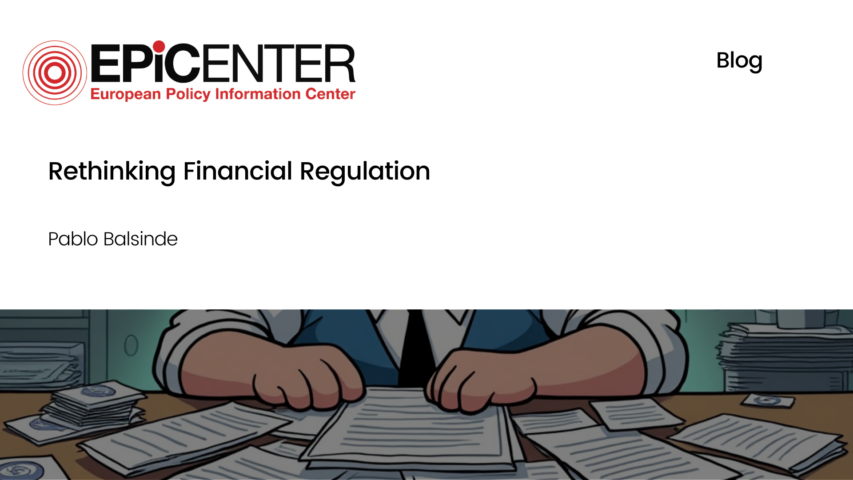Rethinking Financial Regulation

Rethinking Financial Regulation
Pablo Balsinde // 16 January 2017
Since Donald Trump’s election, US bank stocks have risen around 24 percent. Moreover, UK bank stocks have reached 6-month highs in January, albeit tempered by the fall in the sterling exchange rate since June. This rise in expected profitability of American and British banks is in sharp contrast to the state of Eurozone banking – which never seemed to have fully recovered from the financial crisis and has been stagnant for months. The bullish state of Anglo-Saxon banking is clearly not driven by fundamental value changes, but rather by an expectation of macroeconomic and political changes. These include gradual interest rate hikes and the promises of the Trump administration, whose plans include repealing or changing the Dodd-Frank Act – the post-crisis legislation spearheaded by a Democratic Congress and administration – including the Volcker Rule banning proprietary trading.
Given that these tentative policy changes are concurrent with the second longest-running bull market in American history, regulators from the U.S., Europe, and much of the world are wary of the overvaluation and therefore recessionary effects this bubble might have. Consequently, it is expected that U.S. and European authorities will introduce more stringent regulation of several kinds. Given that they would significantly further weaken the financial services industry, Europe’s recent resistance to increasing capital ratios should be lauded; however, it is necessary for regulatory authorities to reconsider the aim and effects of such capital requirements, as well as to re-evaluate other regulations the European Commission has been putting forward.
It is clear that the American and British banks’ situations are quite different from their European counterparts. European banks including Deutsche Bank, Monte dei Paschi, and Santander have struggled with low profitability, amid macroeconomic uncertainty, because of persistently low interest rates and stringent capital requirements. Deutsche Bank, for example, reached a historically low share price last fall. To respond to the obvious fragility of the European financial system, and the uncertainty of the American bull market, financial regulators worldwide are seeking to increase transparency and regulations. Most importantly, the completion of Basel III (informally dubbed Basel IV), which are to be signed imminently by the most important global financial regulators like the Financial Stability Board (U.S.A.) and the Financial Services Agency (Japan), will very likely introduce higher reserve capital requirements.
Europe’s resistance to the increase of capital floors is an important deviation from this trend, and should be applauded given that larger capital requirements would only restrict bank profitability further. The efforts of Valdis Dombrovskis, for example, have delayed the signing of Basel III because of this crucial issue. However, European regulators still support the current capital requirements. The European Banking Authority, for example, released a report reiterating support for cycle-sensitive buffers – reserve requirements that vary depending on the cyclical macroeconomic state of the surrounding economy.
Even though the European Commission has opposed increasing capital ratios in the Basel III accords, they implemented other regulations this year such as a stricter adjustment to the net stable funding ratio. There is, however, a paradox at the heart of recent regulatory moves. Risk based capital requirements have been one of the strongest limits to banking profitability, and have slashed the capability of banks to fund themselves. This, in turn, has created a weaker financial sector which may lack the capacity to resist another financial collapse.
There is a widely-held belief that effective regulation implies a limit to the potential success of the regulated industry – and it is precisely this idea that we argue against. Given that regulation is appropriate, the most effective regulation will be the one that manages the risk in the industry while at the same time secures the strength of the industry being regulated. Although one might argue that the current regulations reduce the risk of financial failure, yet they have done so to the extent that they have put the industry in a position where they would not have the capacity to survive said financial collapse. Further regulation along the lines suggested may only weaken the position of European banks and their ability compete around the globe. Although the negative externalities from bank failure provide more than enough economic justification for banking regulation, there is reason to believe that post-2008 legislation has needlessly restricted the performance of banks whilst also potentially increasing systemic risk.
For example, the most important way in which the Basel Banking Committee determines how to set capital ratios is by establishing minimum requirements based on risk adjusted assets (RWA). Although other capital measures, such as leverage ratios, are adequate markers of a bank’s financial strength, risk-sensitive ratios create incentives for banking institutions to grow their opaque derivatives markets, in what is known as regulatory arbitrage. These derivatives markets yield products which require complicated valuation methods, making their true risk hard to determine. Moreover, in many cases firms are allowed to construct their risk modeling for these products themselves. It is clear then that incentives are set in place for firms to deflate their risk-weighted assets so as to reduce their capital requirements. But even if one disregards this issue by stating, somewhat fairly, that these are problems of transparency, stringent risk-based capital requirements encourage the proliferation of hybrid securities to match their regulatory capital needs – behavior which ultimately brings more risk to the system and hurts financial institutions.
European regulators should evaluate their policy of simply raising capital requirements and think about different ways financial institutions can be regulated and supervised. Exploring giving much more importance to leverage ratios or transparency is one possible direction, since this one would reduce perverse incentives and the likelihood and magnitude of another financial crisis, but the current approach will only weaken the lending industry and therefore the European economy.
EPICENTER publications and contributions from our member think tanks are designed to promote the discussion of economic issues and the role of markets in solving economic and social problems. As with all EPICENTER publications, the views expressed here are those of the author and not EPICENTER or its member think tanks (which have no corporate view).



